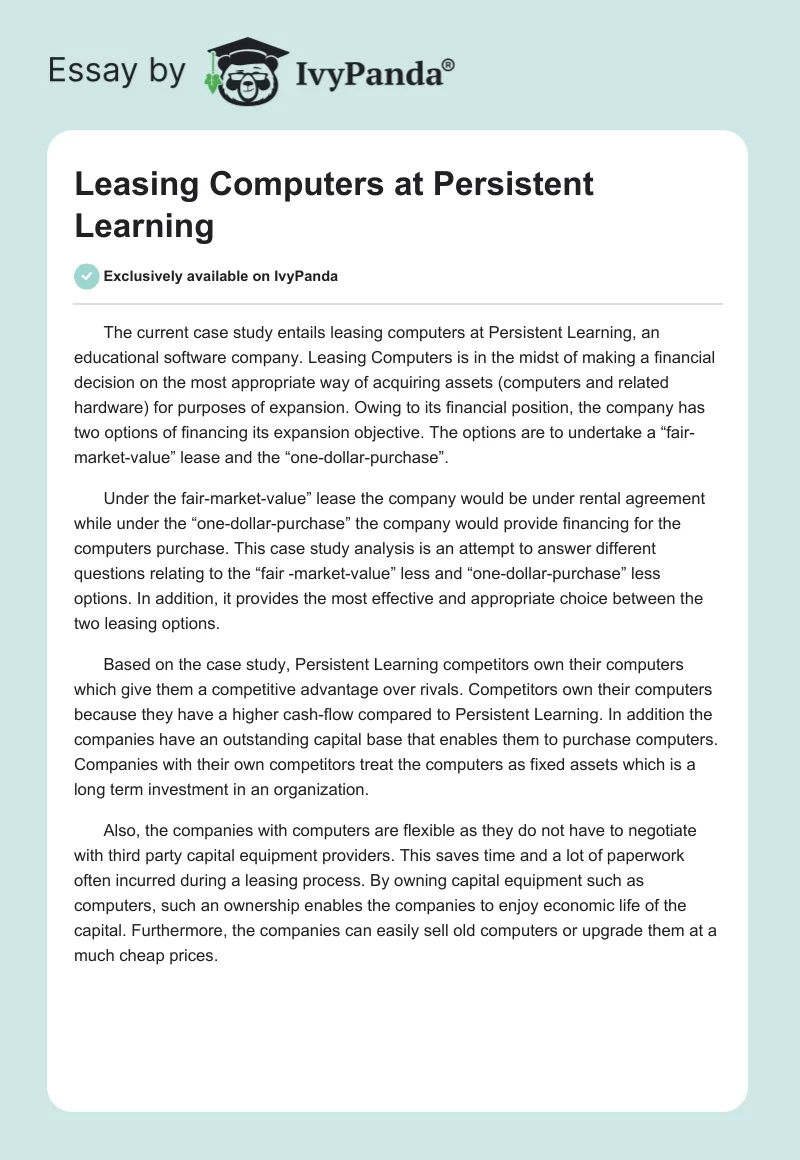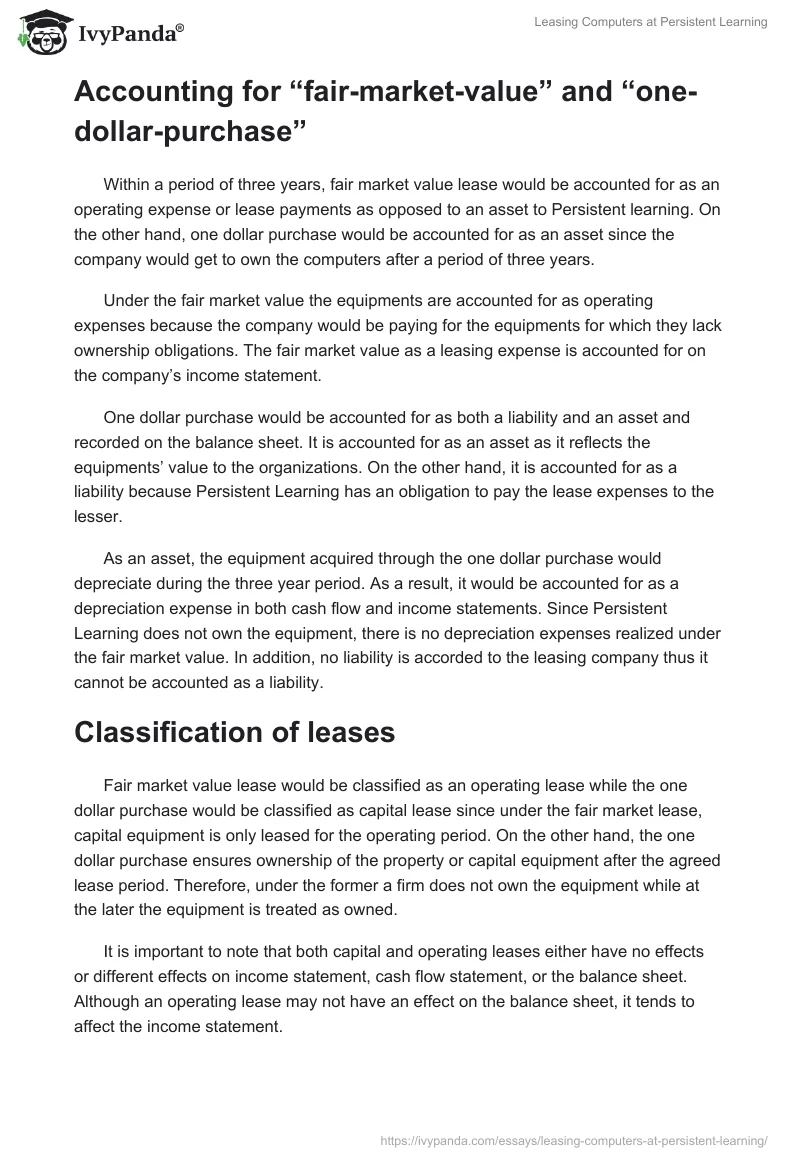The current case study entails leasing computers at Persistent Learning, an educational software company. Leasing Computers is in the midst of making a financial decision on the most appropriate way of acquiring assets (computers and related hardware) for purposes of expansion. Owing to its financial position, the company has two options of financing its expansion objective. The options are to undertake a “fair-market-value” lease and the “one-dollar-purchase”.
Under the fair-market-value” lease the company would be under rental agreement while under the “one-dollar-purchase” the company would provide financing for the computers purchase. This case study analysis is an attempt to answer different questions relating to the “fair -market-value” less and “one-dollar-purchase” less options. In addition, it provides the most effective and appropriate choice between the two leasing options.
Based on the case study, Persistent Learning competitors own their computers which give them a competitive advantage over rivals. Competitors own their computers because they have a higher cash-flow compared to Persistent Learning. In addition the companies have an outstanding capital base that enables them to purchase computers. Companies with their own competitors treat the computers as fixed assets which is a long term investment in an organization.
Also, the companies with computers are flexible as they do not have to negotiate with third party capital equipment providers. This saves time and a lot of paperwork often incurred during a leasing process. By owning capital equipment such as computers, such an ownership enables the companies to enjoy economic life of the capital. Furthermore, the companies can easily sell old computers or upgrade them at a much cheap prices.
Accounting for “fair-market-value” and “one-dollar-purchase”
Within a period of three years, fair market value lease would be accounted for as an operating expense or lease payments as opposed to an asset to Persistent learning. On the other hand, one dollar purchase would be accounted for as an asset since the company would get to own the computers after a period of three years.
Under the fair market value the equipments are accounted for as operating expenses because the company would be paying for the equipments for which they lack ownership obligations. The fair market value as a leasing expense is accounted for on the company’s income statement.
One dollar purchase would be accounted for as both a liability and an asset and recorded on the balance sheet. It is accounted for as an asset as it reflects the equipments’ value to the organizations. On the other hand, it is accounted for as a liability because Persistent Learning has an obligation to pay the lease expenses to the lesser.
As an asset, the equipment acquired through the one dollar purchase would depreciate during the three year period. As a result, it would be accounted for as a depreciation expense in both cash flow and income statements. Since Persistent Learning does not own the equipment, there is no depreciation expenses realized under the fair market value. In addition, no liability is accorded to the leasing company thus it cannot be accounted as a liability.
Classification of leases
Fair market value lease would be classified as an operating lease while the one dollar purchase would be classified as capital lease since under the fair market lease, capital equipment is only leased for the operating period. On the other hand, the one dollar purchase ensures ownership of the property or capital equipment after the agreed lease period. Therefore, under the former a firm does not own the equipment while at the later the equipment is treated as owned.
It is important to note that both capital and operating leases either have no effects or different effects on income statement, cash flow statement, or the balance sheet. Although an operating lease may not have an effect on the balance sheet, it tends to affect the income statement.
On the other hand, capital lease has an effect on the balance sheet and income statement. For instance, depreciation of funds under the capital lease lowers their value on the balance sheet, while at the same time recording a depreciation of expenses, which is seen in the income statement.
Operating lease is reflected on the income statement as expenses incurred during the accounting period. Therefore, operating expenses act as lease payment which is an expense that reduces net income. Total cash flow statements are not affected by capital and operating leases since the actual cash flow remains constant even if a lease is accounted for as an operating lease of a capital lease.
With regard to income statement, cash flow under the income statement tends to be comparatively higher in comparison with cash flow under an operating lease. The reason behind this is that under capital lease, a lease is treated as an asset which depreciates as cash flow inclines during the lease period.
Appropriate lease alternative for Persistent Learning
The best leasing alternative for Persistent Learning based on the case study is the “Fair-market-value” lease. In this alternative, the company would engage in a rental agreement. It is the cheapest option under the circumstances and the most appropriate type of lease as it is flexible and Persistent Learning can still purchase the equipment after a period of three years at the prevailing market fair value.
The company is certain that the capital equipment would be needed for a period of three years. Because of market uncertainty and obsolescence of equipments, Persistent Learning would choose the “Fair-market-value” lease. In addition, the company would not require the computers after three years. So there is no need to own computers at the end of three years and sell them at lower prices. Having to dispose or sell the computers is a time consuming process which is also costly.
Based on the case study, the company plans to use the computers in three years and the economic life of the computers is 5 years. Therefore, the lease period is defined to be less than 75% of the capital equipment’s expected economic life which makes Persistent Learning qualify for fair market value lease.
On the other hand, the present value for the lease payments is less than 90 percent of the equipment. Persistent Learning would have to pay for the equipment usage for three years and supposing that it still needs the equipment for another year, the company has the choice to renew the lease.
Alternatively, Persistent Learning can choose to purchase the computers at the fair market value. In this kind of purchase, Persistent Learning would buy the computers after calculating the equipments depreciation in a period of three years. Lastly, the monthly lease rates are lower in fair market value lease compared to the one dollar purchase. Therefore, I would prefer the fair market value lease to the one dollar purchase.
Principal arguments for and against capital leases
Initially, capital and operating leases were recorded differently but the reevaluation by the FASB would now ensure that all leases are treated as capital leases. In other words, all leases would be recorded as liabilities and assets. Capital leases have the capacity to recognize expenses (liabilities and depreciation expenses) compared to operating leases. As a result, leases would be recognized as liability and as an asset when accounted for in a balance sheet.
Consequently, firms (lessee) would be in a position to claim for depreciation of the leased capital equipment annually. In addition, the lessee would be allowed to deduct the interest expense in each financial year. Operational leases are not shown on a firm’s balance sheet like it is the case for capital leases. Therefore, treating all leases as capital leases would ensure that leases are recorded on the balance sheet thus showing the financial position of a firm to creditors.
One of the major arguments against this move is that debt level reported would increase. This is because classification of operating leases as capital leases would require the levels of reported debts to be exposed to financiers which have effect on individual credibility. In addition, this would have an impact on debt covenant compliance. Another argument against the change is an anticipated increase in lease expenses.
Under operating leases, the lease expenses remained constant for the agreed period. However, treating leases as capital leases would increase lease costs. By reclassifying the leases, the level of debt indicated in the balance sheet would be increased by firms operating large operating leases. This may have negative effect on the financial position of an organization. Lastly, the commitments by lessee to not assume ownership of capital equipment after the lapse of lease period should not be treated as a debt but rather as a rational choice.


